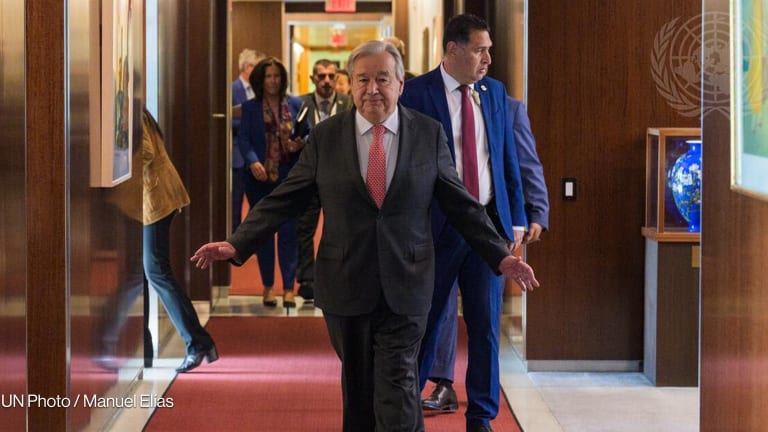Change is coming to the World Bank… or is it?
Can a group of McKinsey consultants, 43 staff proposals and a president bent on reform achieve what past World Bank chiefs have struggled with? A behind-the-scenes look at Jim Kim’s plans to reform one of the largest aid institutions on the planet.
Employees are anxiously awaiting what happens next as President Jim Yong Kim’s World Bank reform agenda moves from a flurry of proposals down an uncertain path toward implementation. Already, 43 reform proposals submitted by staff working groups have caused internal message boards to light up with anonymous comments that run the gamut from enthusiastic support to deep skepticism. The rampant speculation is testing the leadership’s ability to manage employee expectations. The bank’s long-awaited transformation took a sudden, unexpected turn last month when Kim sent an internal memo to announce the impending departure of two managing directors with more than 50 years of bank experience between them — Caroline Anstey and Pamela Cox. Kim gave no explanation for their departure in the memo, leading to widespread rumors and conjecture as to why they were asked to leave so suddenly, according to several World Bank staff members Devex spoke with in the past few days. Most World Bank sources asked to remain anonymous in order not to run afoul the bank’s strict disclosure policies. Uncertainty seems to abound at the bank these days as employees question whether Kim’s efforts will bring about much-needed reform or a distracting process with few results. And, whether ultimately beneficial or not, these efforts could entail a complete overhaul of the bank’s organization and strategy that may lead to deep cuts for certain programs and departments. That said, current and past employees agree: The bank needs change. Complaints about bank policies and work culture aren’t new. In recent conversations with Devex, several bank employees cited poor management and policies around staff promotions that put technical specialists in managerial roles even if they lack experience or interest in managing teams. Others condemned a culture of cronyism, where allied groups stick together and appointments are prone to favoritism. Current and former employees argue the bank has an “old-fashioned approach to risk management” and rewards those who toe the line, while struggling to attract the kinds of entrepreneurs and risk takers Kim appears eager to court now. The bank “needs to run meetings better so that dissenting views are listened to, and not just tolerated or fought tooth-and-nail,” Paul Cadario, a distinguished senior fellow in global innovation at the University of Toronto and former senior manager at the World Bank, told Devex. The bank faces a vastly different development landscape than in decades past, characterized by the emergence of new donors and the realization that private overseas capital flows far exceed official development assistance. The need to stay relevant as a premier development financial institution — and overcome some of the bad publicity the bank has met over the years — adds a sense of urgency to the calls for change. In an effort to zero in on areas where the bank still maintains a competitive advantage, Kim has pledged to turn it from the “knowledge bank” envisioned by his predecessors — especially former President James Wolfensohn — into what Kim calls a “solutions bank”. To do so, he seeks a streamlined agency with a narrowed mission — ending extreme poverty by 2030 and fostering inclusive growth. That goal isn’t just ambitious, it may also require painful reforms for a bank that Kim himself has, according to some observers, found lacking in technical expertise. Kim’s arrival last year ushered in a period of fresh optimism, said Cadario, who was a senior manager at the time. Many felt the new president projected greater openness and accessibility than his predecessors, and also a greater appetite for reform, even after Robert Zoellick’s much-lauded steps to open the bank’s treasure troves of data to the public. One of Kim’s first moves showed early on the difficulty of effecting change at an institution where norms and procedures are so deeply engrained. In an attempt to make them more accessible, Kim asked the bank’s vice presidents to share his open-floor office space. Several VPs resisted the move, claiming it was impractical to be away from their staff, and ultimately settled on a compromise whereby they split their time between the old and new office spaces in what some employees consider a cumbersome, awkward arrangement. Kim’s attention to committing the bank to delivering on “shared prosperity” has generated much praise within the institution and beyond, as it is seen to provide a “global rationale” and more inclusive mission than a singular focus on extreme poverty otherwise would have done. Kim’s public health background and experience at the World Health Organization has stirred hope that he’ll be more results-focused than past presidents. “Dr. Kim was dealing with public health where you can measure things and you can try things out, and you have a professional and ethical obligation if something’s not working to stop,” Cadario said. Everyone bought into Kim’s focus on “delivering results,” even if they were not sure how exactly the new approach would square with the bank’s engrained practices and procedures, Cadario added. But since the early days of Kim’s tenure, hope and optimism have been tempered by questions about whether he truly can deliver on the lofty expectations. Some feel the organizational change Kim promised is being orchestrated behind closed doors by the consultants he brought on board to assess the bank’s organizational culture, while public meetings to generate feedback from employees resemble what one observer called “public ‘ra ra’ sessions” instead of genuine learning opportunities. That said, while some employees feel information is being hidden from them, others argue the information they are seeking doesn’t exist yet, and employees have been informed and involved in the decision-making process in a way that has never happened before at the bank. McKinsey consultants and 43 staff proposals The bank’s organizational revamp began in January when Kim invited the consulting firm McKinsey & Co. to conduct an organizational health survey. The fact-finding mission continued with a two-day dialogue between leadership and staff called “follow the sun” during which senior managers sought input, which they promised to integrate into a system for changing the bank’s organizational culture. Based on findings from these assessments, Kim established working groups in seven areas, composed of mid-level staff tasked with considering how to improve specific areas of the bank’s operations, including client engagement, human resources, risk, budget strategy, and “leadership, talent and people.” These seven working groups produced a list of 43 proposals, intended to address the deficiencies found during the assessment process. The proposals were distributed throughout the bank for comments and ultimately approved by bank senior management. Among the most significant proposals are the establishment of “global practices,” intended to make the bank’s technical expertise more fluid across regions, as well as the introduction of parallel career tracks to differentiate managerial from technical positions. Now, Kim says a senior management team will take all of the proposals and distill them into a bank strategy, the first World Bank organizational strategy in years. Some see the challenge of moving from 43 discreet proposals to an integrated strategy for change as the most important piece of the transformation process — and the biggest question mark — since the proposals currently offer no guidance as to how reforms would be sequenced, what would come first, or how they would be implemented. “It looks like you took 43 working groups and took their decision and then just bolted them all together,” said Cadario. “That’s not how you solve a complex organizational problem.” At this point, two big questions seem to be at the fore: What will be the big first step towards change, and will there be tough cuts to departments and programs that do not fit neatly into the new bank vision? Questions remain about the creation of “global practices” and how these would upset the current “matrix” system, which includes networks of specialists who focus on different development sectors. Another question: How would the shift to making technical knowledge more useful around the world affect locally hired staff members, who currently only tend to work in the countries where they are citizens and whose qualifications, while well-suited to national contexts, may not translate easily to a more globalized role? And a concern particularly for staff members with families: How would the introduction of global practices change staff members’ travel patterns? Kim plans to present his strategy at the World Bank Group’s annual meeting in October. If the board approves it, it will have to be incorporated into the bank’s next budget. The budget process, observers say, would reveal any potential cuts that would need to be made to departments or programs in order to accomplish the bank’s refined focus and management changes. Before that happens though, Kim and his team will have to generate some buy-in from their employees, current and former staff members tell Devex. “What’s the big first step that will get everybody assured that things will work well?” Cadario asked, noting that the success of any change effort depends on an early victory employees can look to and say, “Oh, we did that. That was a good thing to do.” Many agree Kim’s ability to balance short-term successes with a long-term vision will pose the crucial test of his leadership during the reform process, and Cadario remains cautiously optimistic. “It’s too early, and it would be absolutely inappropriate to say this is going to fail. If there are enough people of good will and the engagement of middle managers, and there is a determination to be fair, this will work,” Cadario said. For now, bank employees and the rest of the development community continue to wait, hoping and wondering about Kim’s next big announcement. Read more World Bank news and career advice, and check out World Bank jobs, projects and tenders. Read more development aid news online, and subscribe to The Development Newswire to receive top international development headlines from the world’s leading donors, news sources and opinion leaders — emailed to you FREE every business day.
Employees are anxiously awaiting what happens next as President Jim Yong Kim’s World Bank reform agenda moves from a flurry of proposals down an uncertain path toward implementation.
Already, 43 reform proposals submitted by staff working groups have caused internal message boards to light up with anonymous comments that run the gamut from enthusiastic support to deep skepticism. The rampant speculation is testing the leadership’s ability to manage employee expectations.
The bank’s long-awaited transformation took a sudden, unexpected turn last month when Kim sent an internal memo to announce the impending departure of two managing directors with more than 50 years of bank experience between them — Caroline Anstey and Pamela Cox.
This story is forDevex Promembers
Unlock this story now with a 15-day free trial of Devex Pro.
With a Devex Pro subscription you'll get access to deeper analysis and exclusive insights from our reporters and analysts.
Start my free trialRequest a group subscription Printing articles to share with others is a breach of our terms and conditions and copyright policy. Please use the sharing options on the left side of the article. Devex Pro members may share up to 10 articles per month using the Pro share tool ( ).
Michael Igoe is a Senior Reporter with Devex, based in Washington, D.C. He covers U.S. foreign aid, global health, climate change, and development finance. Prior to joining Devex, Michael researched water management and climate change adaptation in post-Soviet Central Asia, where he also wrote for EurasiaNet. Michael earned his bachelor's degree from Bowdoin College, where he majored in Russian, and his master’s degree from the University of Montana, where he studied international conservation and development.








